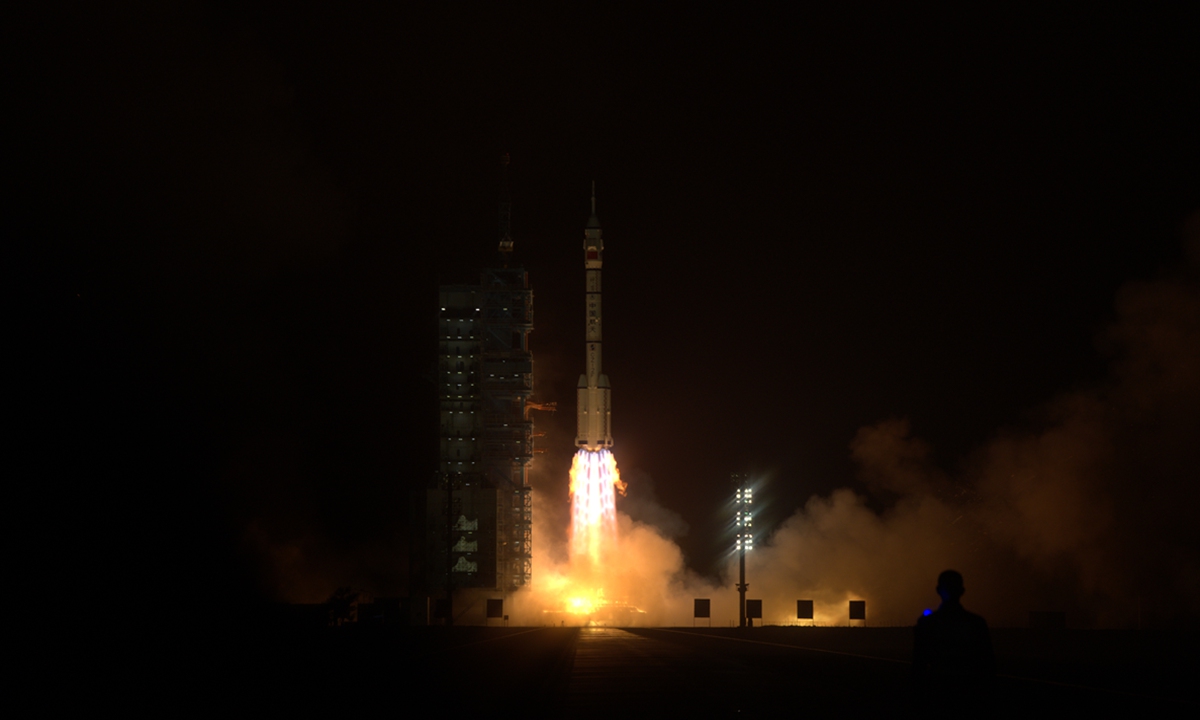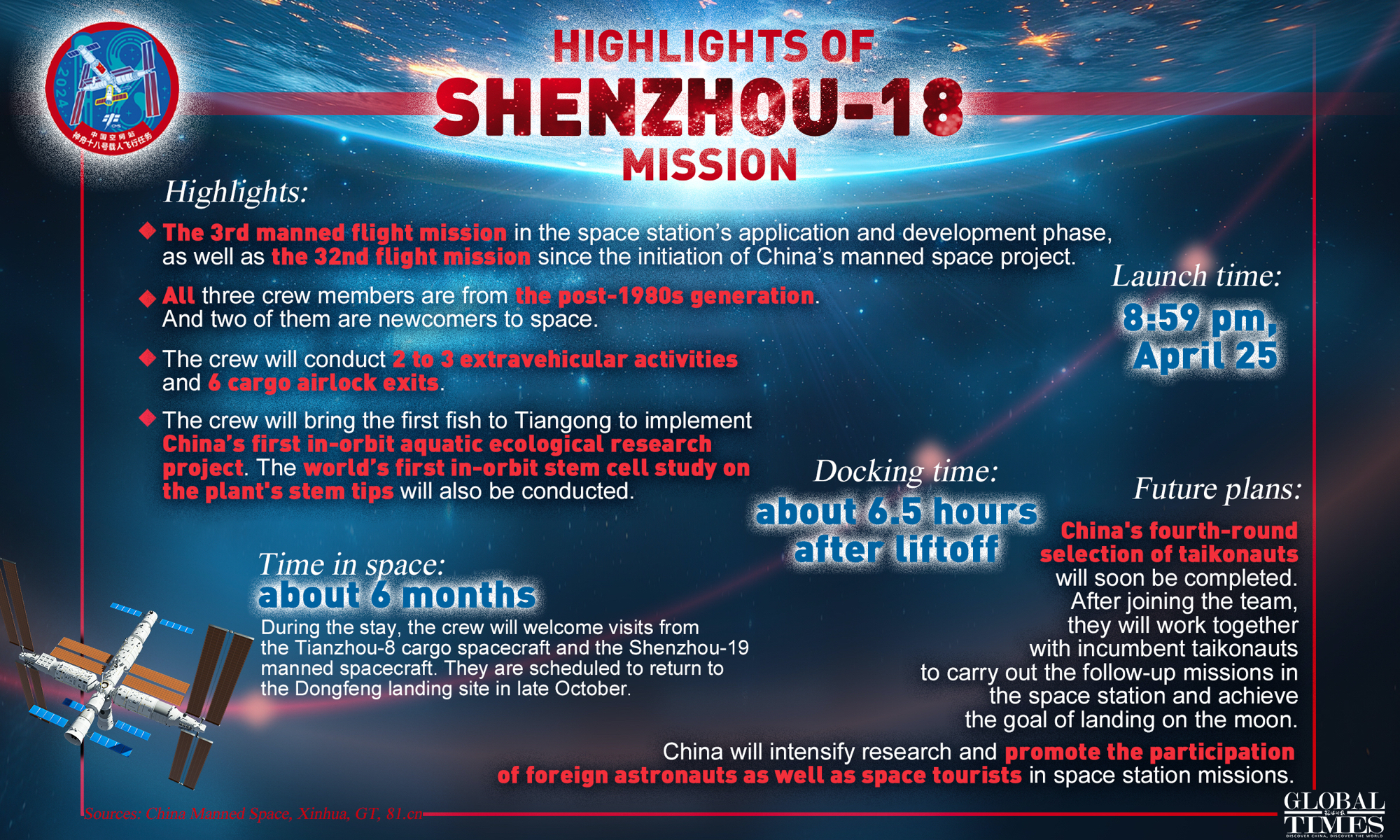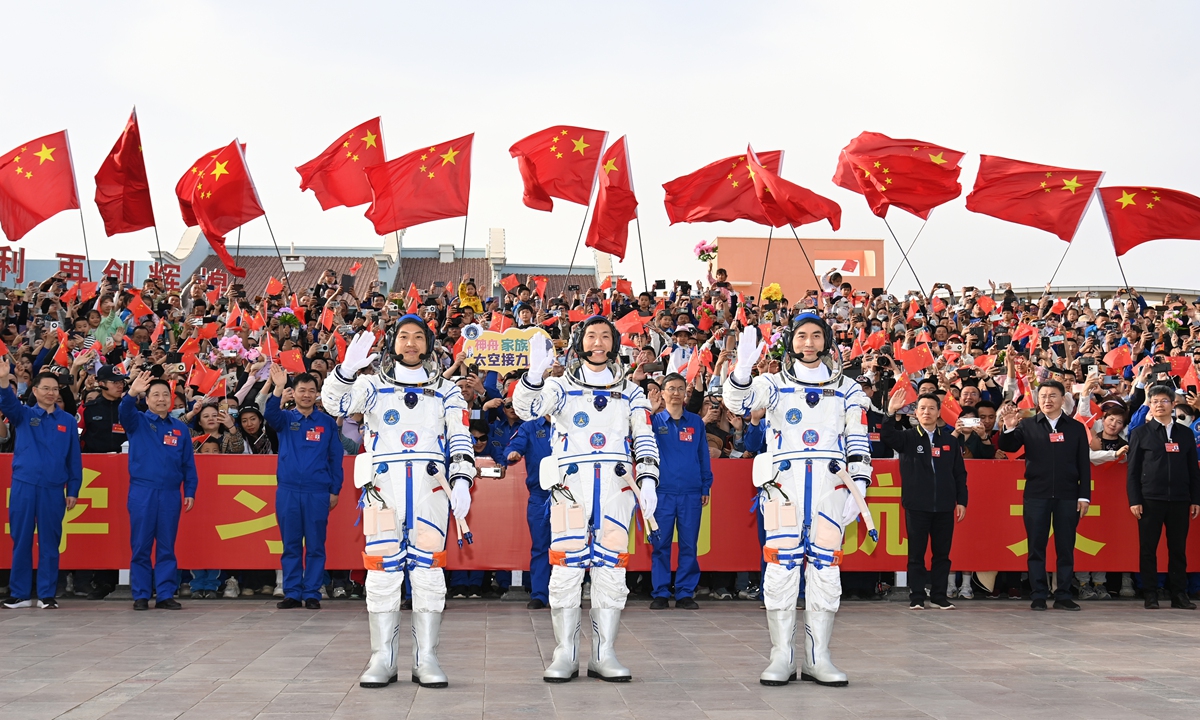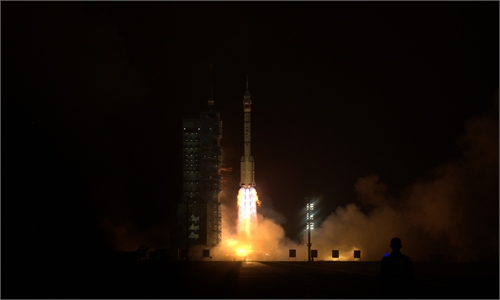Shenzhou-18 successfully launched, sending three taikonauts, fish to Chinese space station

The Shenzhou-18 manned spaceship, atop a Long March-2F carrier rocket, blasts off from the Jiuquan Satellite Launch Center in northwest China, April 25, 2024. Photo: Fan Anqi/GT
Following a smooth 10-minute flight, the Shenzhou-18 spacecraft successfully entered its planned orbit, as confirmed by a statement the China Manned Space Agency (CMSA) sent to the Global Times.
After entering its orbit, the Shenzhou-18 spacecraft adopted an autonomous rapid rendezvous, successfully docking with the Tianhe core module's radial docking port approximately 6.5 hours post-launch. This marked the formation of a three-ship, three-module complex.
Radial docking is a critical part of this mission. Compared to the more familiar forward and backward rendezvous and docking tasks, radial docking is "more like a complex action movie," officials with the China Aerospace Science and Technology Corp (CASC), China's leading space contractor, told the Global Times on Thursday.
"The hundred-ton class assembly of the space station could obstruct the spacecraft's measurement sensors, and there will be mutual impact of plumes from the station's engines… These will all pose significant challenges for radial docking. To eliminate the risks, we have minimized performance parameter deviations at each stage and verified that the docking mechanism has the capture and buffer capability under 31 complex conditions," the CASC said in a statement.

Highlights of Shenzhou-18 mission Graphic: Xu Zihe/GT
The Shenzhou-18 manned spacecraft is the second in the space station's application and development phase to implement radial docking. Prior to this mission, Shenzhou-16 had already successfully completed radial docking with the Chinese space station on May 30, 2023.The current radial docking will further mark the maturity of China's independently developed space rendezvous and docking GNC (Guidance, Navigation, and Control) technology, said CNSA in its statement.
As manned missions to Tiangong have become normalized, more than 90 experiments are scheduled to be carried out in and outside of the space station during Shenzhou-18's six-month stay. These experiments include various fields such as microgravity basic physics, space materials science, space life science, aerospace medicine, and aerospace technology, CMSA spokesperson Lin Xiqiang said Wednesday while detailing the mission one day prior to the launch.

Chinese taikonauts Ye Guangfu (right), Li Cong (center) and Li Guangsu, crew members of the Shenzhou-18 manned spacecraft, attend a seeing-off ceremony at the Jiuquan Satellite Launch Center in Northwest China on April 25, 2024. Shenzhou-18 soared into the sky atop the Long March-2F Y18 carrier rocket on 8:59 pm on the day, carrying the three taikonauts and nearly 100 experimental projects to the Chinese space station.
'The fourth crew member'One of the highlights for this trip is the adventure of the very first fish, which has been dubbed adorably by Chinese netizens as "the fourth crew member of Shenzhou-18."
Using zebrafish and hornwort, "the experiment will be China's first in-orbit aquatic ecological research project, which aims to make a breakthrough in the cultivation of vertebrates in space," Lin said.
"In the broader picture, this ecosystem could potentially serve as a model for creating new ecological environments in space, including food ecosystems. On a smaller scale, the microgravity and radiation effects of space, if prolonged, are still unknown in terms of their impact on the members of the mini ecosystem and the material and energy cycles within the new ecosystem, which can provide new insights to our understanding toward space," Cang Huaixing, a research fellow at the Technology and Engineering Center for Space Utilization, Chinese Academy of Sciences, told the Global Times.
"Additionally, our device is equipped with a CCD for photography and video recording, enabling and facilitating behavioral studies of the fish," Cang said. "In fact, my observations in recent days have been surprising. The behavior of the fish is much more complex than we had previously imagined."
The selection of the fortunate "fourth member" is not just because zebrafish are beautiful, but also because they are well-known "model organisms" in the scientific community.
They have advantages such as small size, short development cycle, and short experimental period. What's more, zebrafish eggs are transparent, making it easy for researchers to observe the process of embryonic development.
More importantly, zebrafish share 87 percent genetic similarity with humans, making them suitable for studying and revealing universal principles of life forms.
In 2012, Japan had also sent a zebrafish aquarium to the International Space Station to observe the effects of microgravity on osteoblast and osteoclast activity.
Cang told the Global Times that while Japan's research focused on fish as the subject, China's goal is to construct and study an entire ecosystem.
Apart from raising fish, the Shenzhou-18 crew will also conduct the world's first in-orbit stem cell study on the plant's stem tips, to reveal the mechanism of plant evolutionary adaptation to gravity and provide theoretical support for space cropping, the CMSA revealed.
The prevention and damage repair of space debris impact will also be a key task during their stay.
"With human space activities rapidly increasing in recent years, the problem of space debris has become more prominent," Lin said. He noted that they had previously discovered that some of the solar panel cables on the space station were damaged by space debris impacts, leading to a partial loss of power supply capacity.
Building on the existing space debris protection mechanism at the station, the Shenzhou-18 crew will install debris protection reinforcement devices on external pipelines, cables, and key equipment during their extravehicular activities (EVAs). They will also conduct external inspections as needed to further ensure the safety of the space station.
In total, the Shenzhou-18 taikonauts are expected to carry out two to three EVAs and implement six cargo outbound deliveries via the station's cargo airlock module.
Heading to the moon
In February, CMSA revealed that landing Chinese on the moon has become the next priority for the country's space exploration now that the construction of Tiangong has been completed.
With the overall goal of achieving a lunar landing by 2030, research and development of various systems are currently under way as planned. The necessary design work for the Long March-10 carrier rocket, the Mengzhou manned spacecraft, Lanyue lunar lander, and lunar suits have all completed and are now in the process of producing initial samples and conducting various tests.
Additionally, the spacecraft and lander have completed the development of thermal test products, and the rocket is conducting ground tests of engines.
The construction of the Wenchang manned lunar exploration launch site has also been launched. Now, public solicitation of manned lunar vehicles and lunar payload schemes is underway, with competition for selection.
Compared to space station missions, lunar missions require astronauts to master the normal and emergency operations of the Mengzhou spacecraft and Lanyue lunar lander, as well as lunar surface operations such as entering and exiting the cabin, carrying out activities under one-sixth of normal gravity, driving lunar rovers over long distances, and conducting drilling, sampling, and scientific investigations on the moon.
China's fourth round of taikonaut selection will soon be completed. After joining the team, they will work together with incumbent taikonauts to carry out the follow-up missions in the space station and achieve the goal of landing on the moon.
China National Space Administration (CNSA) also revealed more details of international cooperation in its lunar probe programs on the just-ended China Space Day on Wednesday.
The International Lunar Research Station (ILRS,) a lunar program currently led by the CNSA and Russia's Roscosmos, has added Nicaragua, the Asia-Pacific Space Cooperation Organization (APSCO), and the Arab Union for Astronomy and Space Science as collaborating countries and organizations.
China will cooperate with these three parties in various aspects such as engineering implementation, operation and application of the ILRS program, the CNSA said.

